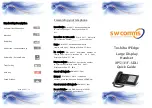
TD 92930EN
13 December 2013 /Ver B
Configuration Manual
WL3 and WL3 Plus WLAN Handset
91
Appendix C: Easy Deployment
C.3
WSG server discovery
2
Once the handset has a WLAN connection, the second step is to automatically
get the IP address to the WSG, that runs the Device Manager, see (2) in
figure
12
.
The two methods, on how to automatically get the IP address, are as follows:
•
Using the vendor option functionality, Option 43 of a DHCP server
•
Using the Ascom Service Discovery Protocol (ASDP) implemented in the handset
In both cases, the IP address received, is not saved, so this process is repeated on
next startup, unless a WSG IP address is set.
C.3.1
Server discovery using the DHCP Option 43
A DHCP server can be configured to return an WSG IP address, as a part of the DHCP
response to the handset, together with other needed DHCP parameters. The WSG IP
address is sent using Option 43 (Vendor Specific Data).
A DHCP request from a handset uses the Option 60 Vendor Class Identifier (VCI) to
identify itself to the DHCP server. (The VCI string: OpenStageWL3, is the Object
Identifier (OID) for the handset). By this, a DHCP server can be configured to return an
WSG IP address only to those clients that expect it. Option 60 also allows different
clients to use different settings in the Option 43, if there are multiple clients in the
network.
After the handset receives the (dynamic) IP address to the Messaging server(WSG), it
tries to login to the Device Manager. The DHCP Option 43 is ignored, once the WSG IP
address is configured (static) in the WSG (in the Device Manager application).
Setting up Option 43 on a DHCP server, is not that very well documented, and not very
known by network administrators. There are many types of clients that can use this
feature, for example, Cisco is using it for its LWAP APs to find a WLAN controller to
attach to.
Examples on how to configure and troubleshoot Option 43 on a Linux and Microsoft
Windows 2003/2008 server, is found at the end of this appendix.
C.3.2
Server discovery using the Ascom Service Discovery Protocol (ASDP)
If the DHCP response does not contain a valid WSG IP address, the handset tries to
find a WSG server using the Ascom Service Discovery Protocol (ASDP) instead. An
ASDP discovery message is sent using UDP to the broadcast IP address, containing
the MAC address of the handset.
A WSG server, configured to respond to ASDP discovery messages, responds with an
ASDP offer as a unicast UDP message sent to the handset.
The protocol allows each WSG support different client services, and can separate
different types of handsets to be serviced by different modules. If there are multiple
WSG modules set up to support ASDP for WLAN, more than one response is received
by the handset. A single response is randomly selected (normally the modules that
responds fastest.)
If no response is received, a new ASDP request is retransmitted periodically, and the IP
address remains unconfigured.















































